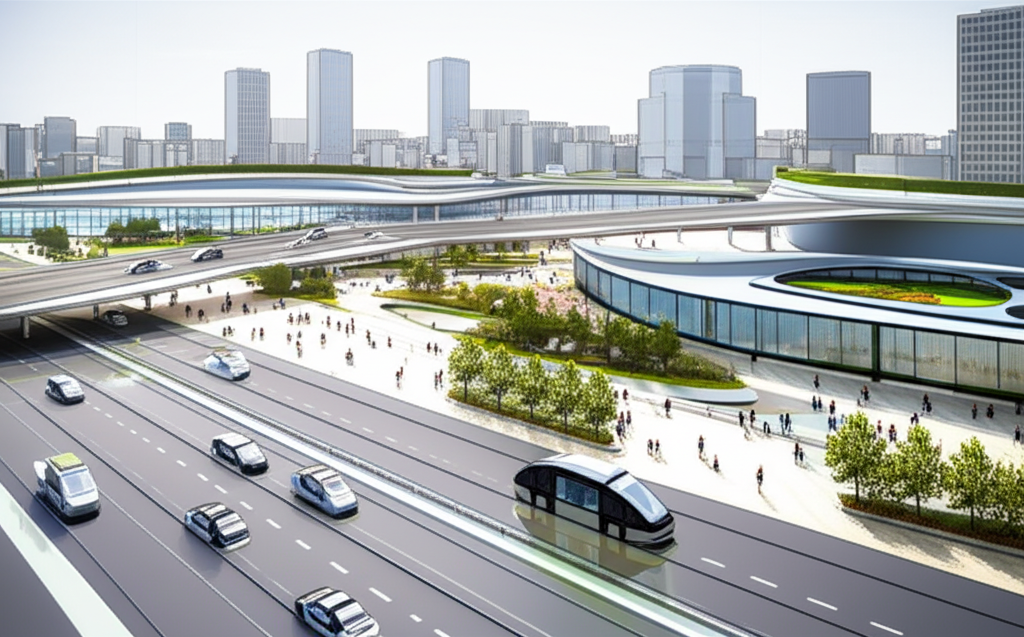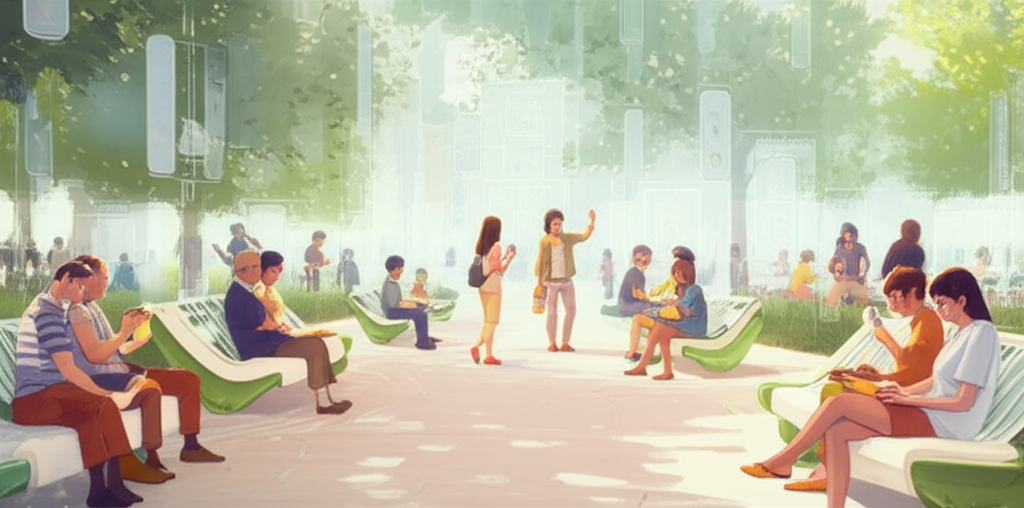Imagine a city without traffic jams, pollution, or wasted effort. Picture a metropolis sculpted by intelligence, where every system runs with perfect harmony. This isn’t just a futuristic fantasy. Artificial Intelligence (AI) is moving beyond our screens. Indeed, it now enters the realm of urban planning. AI promises a new way to build our living spaces, far surpassing traditional methods used for centuries.

Human-centric planning has served us well, of course. However, it often grapples with complex problems. These include resource scarcity and rapid population growth. AI offers a fresh perspective. It is driven by data and predictive power. This blog post explores what an AI-designed “perfect city” would truly entail. Specifically, we will focus on its core pillars. This will show how AI optimizes every aspect for unparalleled living. For a deeper dive into smart city technologies, you might find this article on Smart City Initiatives insightful.
The Blueprint: AI’s Data-Driven Urban Planning
AI processes and analyzes massive amounts of data. Therefore, it approaches city design with unmatched precision. Moreover, AI can see patterns and connections humans often miss.
Predictive Analytics for Optimal Layout
AI would begin by analyzing vast datasets. These include demographics, human movement patterns, and resource consumption. It also analyzes environmental factors and historical data. For instance, AI considers who lives where and how populations shift. It examines how people travel daily and where energy and water are used. Additionally, wind patterns, sunlight, and seismic data are included. Past urban growth and its consequences also provide valuable insights.
This deep analysis helps AI design optimal city layouts from the ground up. Furthermore, it creates dynamic zoning and land use plans. These plans adapt to real-time needs instead of remaining static. For example, AI could reconfigure spaces. It might change a commercial zone into residential areas as populations shift. Also, it could adjust plans when new technologies emerge.
AI also offers powerful simulation capabilities. Before any physical construction, AI tests countless urban configurations. It models traffic flows, energy grids, and public service layouts in virtual environments. Consequently, this ensures maximum efficiency and fewer mistakes before breaking ground.
Resource Allocation and Supply Chain Efficiency
AI precisely manages and optimizes vital resource flows. These resources include energy, water, raw materials, and even waste. AI handles these flows across the entire city. It also helps implement localized production and distribution networks. For instance, consider micro-grids for energy or vertical farms for food. Such systems minimize waste, cut transport costs, and significantly reduce environmental impact.
For instance, AI would optimize agricultural zones. These zones would be within or very near the city. This ensures fresh, hyper-local produce delivery. Ultimately, food travels only a short distance. This leads to a minimal carbon footprint.
Smart Infrastructure: The Living Network Overview
An AI-designed city’s infrastructure is more than just well-planned. It functions as a living, breathing network. This network constantly adapts and optimizes itself.
Autonomous Transportation Systems
Imagine a fully integrated transportation network. AI would manage both public and private options. These options include hyperloops for fast inter-city travel, autonomous electric vehicles, and drone delivery systems. Pedestrian priority zones would also be key.
This system would eliminate traffic congestion completely. Additionally, it would dramatically reduce accidents. The need for vast parking infrastructure would disappear. Consequently, this frees up significant urban space for parks, housing, or other community uses. Transport would become a seamless “mobility-as-a-service.” It would be on-demand, highly efficient, and adapt instantly to individual or collective needs.
Quick Question: How would an AI-driven transportation system handle unexpected events like a sudden weather change?
Answer: An AI system would use real-time data to reroute vehicles instantly. It would also deploy appropriate emergency services and communicate changes to citizens. Furthermore, it learns from every event to improve future responses.
Dynamic Energy Grids and Climate Control
AI would play a central role in managing diverse renewable energy sources. These include solar, wind, geothermal, and even tidal power. It would intelligently distribute power across the city in real-time. Constantly, it predicts demand and supply, thus balancing the grid.
Furthermore, AI would manage adaptive building climates. It controls city-wide environmental systems. These systems use real-time data on weather, building occupancy, and citizen comfort. Moreover, smart materials embedded in infrastructure would react to environmental changes. They optimize insulation and energy use without human intervention.
Intelligent Waste Management and Recycling
Advanced AI-driven systems would sort, recycle, and repurpose waste right at the source. This maximizes resource recovery. Concepts like waste-to-energy conversion, nutrient recycling, and fully circular economies would become standard. Notably, AI makes these possible by managing every step. This means the city could effectively eliminate landfills.
Sustainable Living: A Greener Utopia

A perfect city, designed by AI, prioritizes environmental harmony. It blends technology with nature. This creates a truly sustainable living space.
Moreover, AI would constantly monitor ecological health. It would support native species and manage urban wildlife corridors. Thus, it ensures a thriving natural ecosystem within the city limits.
Water Conservation and Management
AI would implement precision irrigation for parks and farms. This ensures no water is wasted. It would manage advanced wastewater recycling systems. These systems turn used water back into clean, usable water. Moreover, AI also handles intelligent storm surge management and flood prevention. It predicts potential flooding and activates mitigation strategies. Furthermore, sophisticated closed-loop water systems would operate within buildings and neighborhoods. This minimizes water waste even further.
Citizen Experience: Harmony, Health, and Convenience Overview
The ultimate goal of an AI-designed city is to enhance residents’ quality of life. AI would ensure harmony, promote health, and offer unmatched convenience.
Personalized Public Services and Healthcare
AI could tailor public services to individual and community needs. This includes education, healthcare, and recreational facilities. It predicts requirements and offers proactive support. Preventative healthcare would become common. Ubiquitous, anonymized sensors and AI analysis would monitor public health trends. Therefore, this would lead to significantly healthier populations and less strain on medical systems. Personalized learning environments and skill development opportunities would also be continuously updated by AI.
Enhanced Safety and Security
AI could predict and prevent crime before it happens. It would also manage emergencies efficiently. Furthermore, it optimizes first responder deployment using advanced pattern recognition. These systems would operate under strict ethical guidelines and robust privacy safeguards. Adaptive security measures would learn and evolve constantly. This eliminates the need for constant human oversight while maintaining a safe environment.
Key Takeaway: AI-driven safety focuses on prevention and proactive response, not just reaction.
Community Building and Social Cohesion
AI might identify opportunities for community interaction. It would foster social cohesion through intelligently designed public spaces. It could recommend local events based on citizen interests. Additionally, it facilitates resource sharing among residents. Furthermore, AI would play a crucial role. It would ensure equitable access to resources and opportunities for all citizens, addressing systemic inequalities. In summary, it helps create a truly fair and inclusive urban environment.
The Evolving City: Adaptive and Resilient
An AI-designed city is not a static masterpiece. Instead, it is a dynamic, living entity. It continuously learns and improves.
Self-Healing Infrastructure
AI-embedded sensors and robotics could detect and repair infrastructure damage. This includes roads, pipes, and buildings. Significantly, repairs would happen autonomously. This often occurs before humans even notice a problem. Predictive maintenance for all city systems would be standard. Consequently, this minimizes downtime and maximizes the longevity of every component.
Dynamic Adaptation to Change
The AI city would continuously learn and adapt. It would respond to demographic shifts, climate change impacts, technological advancements, and unforeseen global events. Therefore, the city’s ability to reconfigure its physical and digital infrastructure would be key. This ensures optimal performance and citizen satisfaction as needs evolve. Ultimately, it’s a city designed for perpetual improvement.
Quick Question: Could an AI city become too rigid or controlling?
Answer: The design principles of an ethical AI city would prioritize citizen well-being and freedom. Human oversight and feedback loops would be crucial. The AI acts as an optimization engine, not a dictator. It allows for human choice and spontaneity.
Conclusion: More Than Just Smart – It’s Alive
An AI-designed city promises ultimate efficiency, profound sustainability, and unparalleled quality of life. Every citizen’s well-being remains the top priority. This vision moves beyond a mere “smart” city. Instead, it’s a metropolis that is truly intuitive, responsive, and self-optimizing. It behaves like a living organism. It constantly evolves to meet the needs of its inhabitants and its environment.
The profound potential of AI can shape our urban future. It can transform our biggest challenges into opportunities. These lead to a brighter, more harmonious world. Imagine a city that breathes with you, cares for you, and adapts for you. This truly represents the promise of AI in urban design.
Frequently Asked Questions (FAQs)
| Question | Answer |
|---|---|
| Q1: Will AI cities eliminate human jobs in urban planning or other sectors? | AI will likely change job roles, but not eliminate them entirely. AI will handle data analysis and optimization. This frees humans for creative problem-solving, ethical oversight, and direct community engagement. Consequently, new jobs in AI management, maintenance, and human-AI collaboration will emerge. |
| Q2: How would privacy be protected in an AI-designed city with so many sensors? | Privacy would be a core ethical design principle. Data would be anonymized and aggregated where possible. Furthermore, strict protocols for sensitive data, secure encryption, and transparent data usage policies would be in place. Citizens would also have control over their personal data. |
| Q3: Who would control the AI in such a city? | Control would involve a multi-layered approach. This would include human governing bodies, citizen oversight committees, and AI ethics boards. The AI would operate within defined parameters and goals set by humans. It would also have built-in accountability mechanisms. |
| Q4: What about the cost of building an AI-designed city? | Initial infrastructure costs might be high. However, the long-term operational savings would be massive. Efficiency in resource use, reduced waste, lower maintenance needs, and improved public health would offset initial investments over time. |
| Q5: Could an AI city make mistakes or have unforeseen consequences? | Like any complex system, there’s always a risk of errors or unintended outcomes. Continuous learning, robust testing, simulation, and human oversight would minimize these risks. Consequently, the city’s adaptive nature means it can correct and learn from any issues quickly. |
| Q6: How would an AI city handle natural disasters? | AI would significantly improve disaster preparedness and response. For example, it could predict severe weather patterns. It would automate early warning systems, manage evacuation routes, and deploy first responders more efficiently. Additionally, self-healing infrastructure would speed recovery. |
| Q7: Will AI-designed cities feel sterile or devoid of human character? | The goal is to optimize for human well-being and community, not just efficiency. AI could help design diverse, vibrant public spaces. It could also facilitate unique cultural events. Ultimately, it could enhance, rather than diminish, human character. This would happen by removing common urban frustrations. |
| Q8: Can existing cities be retrofitted into AI cities? | Full transformation is challenging, but gradual retrofitting is possible. Existing cities can integrate smart technologies. They can optimize specific systems, such as traffic or energy. Moreover, they can progressively upgrade infrastructure with AI capabilities. Overall, it would be a slower, iterative process. |

